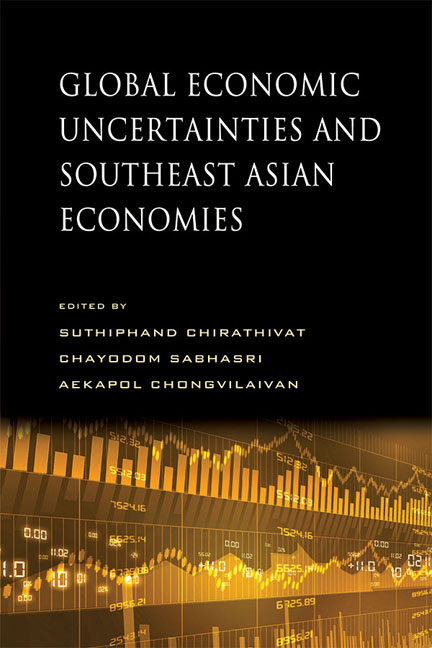Book contents
- Frontmatter
- Contents
- Preface
- Contributors
- 1 Challenges Facing a Globally Connected ASEAN
- 2 Fragile Balance of Payment in Indonesia under Global Economic Uncertainties
- 3 Malaysia in the Midst of Global Economic Uncertainties
- 4 Singapore: Reinventing Itself amid Global Economic Uncertainties
- 5 Thailand: Dependency or Diversification?
- 6 Vietnam's Economic Experience since WTO Accession
- 7 Global Economic Imbalances and Reform Policy: Evidence from Asian Economies
- 8 Foreign Exchange Rate Adjustment Policies in Asia
- 9 Monetary and Financial Architectures for ASEAN+
- 10 Global Uncertainties: Implications for the ASEAN Community
- Index
3 - Malaysia in the Midst of Global Economic Uncertainties
Published online by Cambridge University Press: 22 July 2017
- Frontmatter
- Contents
- Preface
- Contributors
- 1 Challenges Facing a Globally Connected ASEAN
- 2 Fragile Balance of Payment in Indonesia under Global Economic Uncertainties
- 3 Malaysia in the Midst of Global Economic Uncertainties
- 4 Singapore: Reinventing Itself amid Global Economic Uncertainties
- 5 Thailand: Dependency or Diversification?
- 6 Vietnam's Economic Experience since WTO Accession
- 7 Global Economic Imbalances and Reform Policy: Evidence from Asian Economies
- 8 Foreign Exchange Rate Adjustment Policies in Asia
- 9 Monetary and Financial Architectures for ASEAN+
- 10 Global Uncertainties: Implications for the ASEAN Community
- Index
Summary
INTRODUCTION
Malaysia experienced the highest growth rates during the period between the first two economic recessions (namely in 1985 and 1998), from 1986 till 1997, with an average rate of growth of 8.3 per cent. The economy, however, recovered the year following each of the aforementioned crises. The global financial crisis (GFC) in 2008 contributed to another contraction in Malaysia's economic growth in 2009 and an equally rapid recovery the following year. Since then, Malaysia's average growth rate has fallen to 5.4 per cent from 1999 to 2009. The country's population has grown almost threefold from 10.8 million in 1970 to 27.8 million in 2009. Average GDP per capita has grown from RM1,932 to RM19,052 for the same period, placing Malaysia solidly in the upper-middle income group of countries. Although the economy recovered strongly in 2010, with a GDP growth of 7.2 per cent, growth dipped again to 5.1 per cent in 2011 and 2012. Nevertheless, as noted by Hill (2012), Malaysia's growth has been the most volatile, compared with Singapore, Thailand, Korea and China.
Since 2010, global uncertainty has continued to prevail, with recovery dependent on the continued sustainability and strength of private sector activity in the United States, while the need for structural reform and fiscal consolidation implies that recovery in the eurozone will take a longer period (Central Bank 2012). Japan's growth also depends on the success of the aggressive quantitative easing and expansionary policies that have been undertaken since April 2013 to reinvigorate its economy and overcome the output gap and mild deflation that have plagued it since the 1990s. Concurrently, China's slower growth will also have implications for the rest of the world.
In the face of these uncertainties, it is important to examine the key policy initiatives that have been undertaken in Malaysia since 2008, to ascertain the impact of these policies on key economic indicators. Looking ahead, it is equally important to identify the macroeconomic and trade challenges facing the country, as well as the prospects of attaining the status of a high-income economy — targeted for 2020.
The chapter is organized as follows: Section 2 outlines the main policy responses that have been undertaken since 2008, while Section 3 examines their impact on the economic performance of the country. The macroeconomic and trade challenges and prospects are presented in Section 4. The conclusion summarizes the key findings.
- Type
- Chapter
- Information
- Publisher: ISEAS–Yusof Ishak InstitutePrint publication year: 2015



